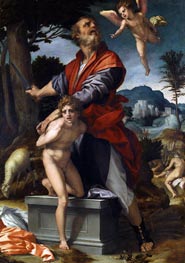
Andrea del Sarto Painting Reproductions 1 of 1
1486-1530
Italian Renaissance Painter
Andrea del Sarto, born Andrea d’Agnolo di Francesco in Florence on July 16, 1486, is a name that often slips into the shadows of the greats - Michelangelo, Leonardo, Raphael. And yet, his peers called him "senza errori" - the faultless painter - for a reason. From his earliest days, del Sarto showed a remarkable talent for precision, his brushstrokes embodying a certain perfection that felt almost mathematical. But this precision, as Vasari liked to remark, was both his gift and his curse.
The son of a tailor, hence the nickname "del Sarto," Andrea wasn’t destined for art, at least not initially. His early apprenticeship was under a goldsmith, before moving on to train with Piero di Cosimo. But as soon as he found himself creating frescoes with Franciabigio in their shared studio, the Florentine scene started taking note of this young man whose use of color could make the viewer feel like they were walking through velvet. The depth, the subtle tones - Andrea had a way with light that could transform the dullest corner into a place of grace.
One of his most significant early commissions was a series of frescoes for the Servite Order at SS Annunziata in Florence. It was here that del Sarto truly carved out his niche. The "Nativity of the Virgin," painted around 1514, is a work where you can feel the influence of masters like Leonardo and Fra Bartolomeo, but it’s undeniably Andrea. The composition is delicate, a tapestry of influences woven with his signature touch of calm perfection. In these frescoes, his figures seem to breathe, their emotions soft and real, rather than the grand drama we might expect from a Renaissance master.
In 1518, Andrea’s talent caught the eye of Francis I of France, and for a moment, it seemed like destiny might lead him down a path of fame and fortune. But his journey to France was a brief one, tainted by Vasari’s infamous tale that Andrea squandered the King’s money on a house for his wife, Lucrezia, instead of returning to complete commissions. Whether true or not, this episode marked a turning point in his career, keeping him tethered to Florence, where he would continue to paint masterworks, though his reputation never quite recovered in Europe.
Del Sarto’s later works, such as "Madonna of the Harpies" (1517), reveal a maturity of vision. His figures remain harmonious, his colors rich, but there's a sense of containment - a careful balance rather than the bold flourish of his contemporaries. His art always seemed to whisper rather than shout, and perhaps that's why history has sometimes overlooked him.
Andrea del Sarto’s legacy endures in his technical brilliance - a precision that holds a quiet beauty, an elegance that transcends his era. And though his life was cut short by the plague in 1530, his paintings continue to speak, soft but sure, to those who take the time to listen.
The son of a tailor, hence the nickname "del Sarto," Andrea wasn’t destined for art, at least not initially. His early apprenticeship was under a goldsmith, before moving on to train with Piero di Cosimo. But as soon as he found himself creating frescoes with Franciabigio in their shared studio, the Florentine scene started taking note of this young man whose use of color could make the viewer feel like they were walking through velvet. The depth, the subtle tones - Andrea had a way with light that could transform the dullest corner into a place of grace.
One of his most significant early commissions was a series of frescoes for the Servite Order at SS Annunziata in Florence. It was here that del Sarto truly carved out his niche. The "Nativity of the Virgin," painted around 1514, is a work where you can feel the influence of masters like Leonardo and Fra Bartolomeo, but it’s undeniably Andrea. The composition is delicate, a tapestry of influences woven with his signature touch of calm perfection. In these frescoes, his figures seem to breathe, their emotions soft and real, rather than the grand drama we might expect from a Renaissance master.
In 1518, Andrea’s talent caught the eye of Francis I of France, and for a moment, it seemed like destiny might lead him down a path of fame and fortune. But his journey to France was a brief one, tainted by Vasari’s infamous tale that Andrea squandered the King’s money on a house for his wife, Lucrezia, instead of returning to complete commissions. Whether true or not, this episode marked a turning point in his career, keeping him tethered to Florence, where he would continue to paint masterworks, though his reputation never quite recovered in Europe.
Del Sarto’s later works, such as "Madonna of the Harpies" (1517), reveal a maturity of vision. His figures remain harmonious, his colors rich, but there's a sense of containment - a careful balance rather than the bold flourish of his contemporaries. His art always seemed to whisper rather than shout, and perhaps that's why history has sometimes overlooked him.
Andrea del Sarto’s legacy endures in his technical brilliance - a precision that holds a quiet beauty, an elegance that transcends his era. And though his life was cut short by the plague in 1530, his paintings continue to speak, soft but sure, to those who take the time to listen.
2 Andrea del Sarto Paintings

The Sacrifice of Isaac c.1528
Oil Painting
$3057
$3057
Canvas Print
$65.85
$65.85
SKU: DSA-16839
Andrea del Sarto
Original Size: 98 x 69 cm
Prado Museum, Madrid, Spain
Andrea del Sarto
Original Size: 98 x 69 cm
Prado Museum, Madrid, Spain

Portrait of a Woman c.1514
Oil Painting
$1741
$1741
Canvas Print
$70.28
$70.28
SKU: DSA-16840
Andrea del Sarto
Original Size: 73 x 56 cm
Prado Museum, Madrid, Spain
Andrea del Sarto
Original Size: 73 x 56 cm
Prado Museum, Madrid, Spain